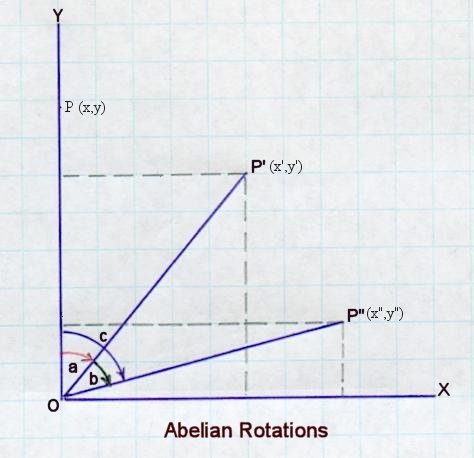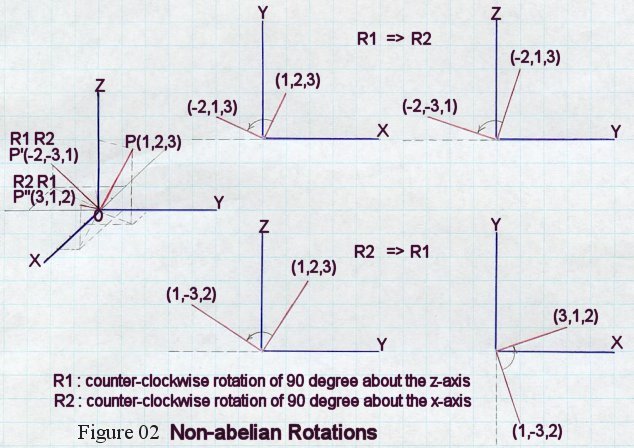Time Travel Research Center © 2005 Cetin BAL - GSM:+90 05366063183 - Turkey/Denizli
Abelion/non-Abelion, and the U(1), SU(2), SU(3) Groups
Contents
Abelion/non-Abelion Groups
The Mathematics of U(1), SU(2), and SU(3) Groups
Application to Elementary Particles
Abelion/non-Abelion Groups
Another example is the two-dimensional rotation shown in the above
diagram. The angular displacement c is the sum of the rotations a and b, the
unit element is a rotation of 0o, and the inverse is a rotation
in the opposite direction. Because the angle of rotation can be
infinitesimally small, this kind of group is called a continuous group.
The transformation formula for a two-dimensional rotational through an angle
a from (x,y) to (x',y') is:
x' = [cos(a)] x + [sin(a)] y ---------- (1)
y' = [-sin(a)] x + [cos(a)] y ---------- (2)
The fact that the laws of physics are unchanged by such a rotation implies
conservation of the z component of angular momentum; in general, whenever
the physical law is invariant under the operation of a symmetry group, there
must be some conserved quantity associated with that operation. This is
sometimes referred to as Noether's theorem, and is a useful feature of group
theory, which can be used to provide physical insights into the behaviour of
interactions and particles such as whether the process is permissible or if
an entity is missing without knowing the detailed dynamic. When this
rotation group is applied to the "internal space" in quantum electrodynamics,
the global operation (same amount of internal rotation everywhere) leads to
the conservation of electric charge; while the local operation associates a
gauge boson (the photon) with the electromagnetic interaction. The rotation
group in real space is called SO(2) operating on a two-dimensional space;
while the one for the "internal space" is called U(1) because the "two-dimensional
space" has been transformed to an equivalent complex number, e.g., z = x +
iy.
As far as only the (residual) strong interaction is concerned, the neutron and proton can be considered as the two states of the "isospin". This system is invariant under the operation of the SU(2) group globally, and leads to two constants of motion: the square of the total "isospin" and the z-component of the "isospin". It is found that if the SU(2) group is applied locally to the electroweak interaction with a system of electron and neutrino (or up and down quarks), three gauge bosons (corresponding to the three parameters) are required to render the system invariant under such operation. The proposed gauge bosons have been found and the electroweak theory has been validated by many experiments.
The Mathematics of U(1), SU(2), and SU(3) Groups
Let's consider the phase transformation of a complex function (with real
and imaginary parts):
f' = e-ia f ---------- (3)
where the phase angle a is a constant for a global transformation. It
is a function of (x,y,z,t) for local transformation.
If f and f' are decomposed into the real and imaginary parts: f = fR
+ fI ---------- (4)
Then Eq.(3) can be re-written as:
f'R = [cos(a)] fR + [sin(a)] fI
---------- (5)
f'I = [-sin(a)] fR + [cos(a)] fI
---------- (6)
which is in the same form as Eqs.(1) and (2) for the 2-dimensional
rotation, but in the fR - fI plane, whose 'coordinates"
are the real and imaginary parts of the function. This plane is called an
internal space, and the associated symmetry an internal symmetry.
Two successive transformations such as: f => f' => f" ---------- (7)
where f" = e-ib f', can be written in the form:
f" = e-i(a+b) f = e-ic f
---------- (8)
with c = a + b. This is a transformation of the same
form as the original one. The set of all such transformations forms what
mathematicians call a group, in this case U(1), meaning the group of all "unitary"
one-dimensional matrices. A unitary matrix U is one such that
UU+ = U+U = I ----------
(9)
where I is the identity (unity matrix) and "+"
denotes the Hermitian conjugate (defined such that the mean value of an
operator is real). Eq.(9) is required for preserving the normalization (probability).
The transformation of the U(1) group have the simple property that it does
not matter in what order they are performed, i.e., a + b =
b + a. Thus U(1) = e-ia = e-ia
. (1) = e-ia . I
is called an Abelian group in which different transformations commute. Since
the phase angle can be infinitesimally small, this kind of group also
belongs to the Lie group which is important in investigating physical system.
In SU(2) the phase angle a = a . I is
replaced by a . t with a = (a1, a2,
a3) - there are now three phase angles, and three 2x2 non-commuting
matrices (generators) for t (they are also known as the Pauli
matrices):
| ---------- (10) |
For the non-Abelion groups, the number of phase angles (parameters) is
determined by the formula Na = n2 - 1, where n is the
dimension of the internal space, e.g., n = 2 => Na = 3 for SU(2).
It can be shown that the absolute square for the determinant of U is
1, i.e., |detU|2 = 1. Thus |detU| can be either +1
or -1. The "S" in "SU" means the transformations are "Special" satisfying |detU|
= +1, which implies continuous roatations without reflections. Therefore
SU(2) designates the group of special, unitary 2x2 matrices.
In SU(3) there are eight phase angles and eight 3x3 non-commuting matrices (generators):
|
|
---------- (11) |
The SU(2) and SU(3) transformations are more like the non-commuting 3-dimensional
rotations of real space because of the non-commuting generators, e.g., a
t1 + b t2 ¬= b t1 + a
t2. These groups are called non-Abelian for this reason.
If we define t2 = t12 + t22
+ t32 + ... ---------- (12)
It can be shown that the phase transformations are characterized by the
eigenvalue of t2 and t3 with eigenvector
|t,m>:
t2 |t,m> = t(t+1) |t,m> ---------- (13)
t3 |t,m> = m |t,m> ---------- (14)
where t is determined by the formula n = 2t +1 (n is the dimension of the
generator) and for a given t, the value of m can be -t, -t+1, ..., t-1, t;
i.e., there are 2t+1 degenerate states for a given t. For example, in the
case of SU(2) n = 2 yields t = 1/2, and m = -1/2 or +1/2.
Application to Elementary Particles
In quantum field
theory, if we demand the system to be invariant under the local phase (or
gauge) transformation such as:

where A is the field for the gauge bosons, gs is the
coupling constant, lambda is the generator. The second term in Eq.(16) is
responsible for the various interactions via the exchange of bosons (see Eqs.(13)
and (38) in "Quantum
Field Theory"). The number of gauage bosons depends on the dimension of
the generator. Thus, there is only the photon for the U(1) group applicable
to electromagnetic interaction; there are three vector bosons - W+,
W-, and Zo for the SU(2) group applicable to weak
interaction; and there are eight gluons for the SU(3) group applicable to
strong interaction (see Table 15-03).
Now let's turn to the physical interpretation of the complex function in
Eq.(3). For the U(1) group this function can be
associated with the two component nucleon doublet (p, n), if
we equate fR = p and fI = n,
where p and n represent the wave function for the proton and
neutron respectively. It was thought that the proton and neutron are the
same particle in different state - p with a positive charge and
isospin +1/2, while n is neutral with isospin -1/2. The dynamic of
these particles are described by the
Klein-Gordon
Equation. Another case applies to the two-component electron wave
function (eL, eR) representing the left-handed
and right-handed states (antiparallel and parallel spin to the momentum
direction as m => 0 or
v => c) respectively. The dynamic of these particles are described by the
Dirac Equation.
Application of the SU(2) group to weak interaction is more complicated
because of parity violation. Since there is noright handed neutrino , the wave functions are split into a left-handed and right-handed
parts:
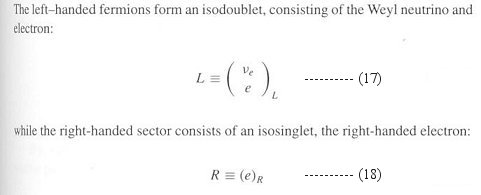
There exists an empirical relation of Gell-Mann and Nishijima for the
electric charge of a particle, namely:
Q = t3 + (Y/2) ---------- (19)
where Q is the charge, t3 is the third component of the generator,
and Y is the "hypercharge".
To satisfy this formula for electro-weak interaction with SU(2) X U(1)
symmetry where the SU(2) group splices together with the U(1) group (no
mixing), L has to be an eigenvector of SU(2) with t = 1/2 and R
an eigenvector of U(1) with t = 0. Similar assignment can be given to the u
(up), d (down), and s (strange) quarks as listed in the table below:
| Particle | Q | t | t3 | Y |
|---|---|---|---|---|
| ve | 0 | 1/2 | 1/2 | -1 |
| eL | -1 | 1/2 | -1/2 | -1 |
| eR | -1 | 0 | 0 | -2 |
| u | 2/3 | 1/2 | 1/2 | 1/3 |
| d | -1/3 | 1/2 | -1/2 | 1/3 |
| s | -1/3 | 0 | 0 | -2/3 |
Table 01 Gell-Mann-Nishijima Relation
where Y = S + B for the quarks with S for the strangeness number, B for
baryon number, which is equal to +1/3 for quark and -1/3 for anti-quark.
In strong interaction the wave functions for the quarks u, d,
and s constitute the fundamental representation of SU(3):
 |
---------- (20) |
Beginning with the fundamental representation in Eq.(20), all
representations of SU(N) can be generated by taking the multiple (tensor)
products. For example, the bound states of mesons can be constructed
according to the following scheme:
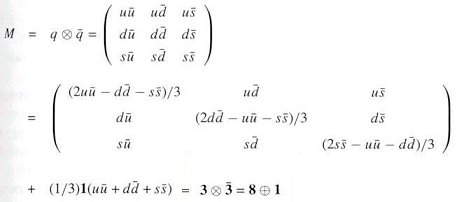 |
---------- (21) |
where the bar "-" denotes anti-particle.
Table 02 lists the relation between the meson wave functions and the quark
pairs.
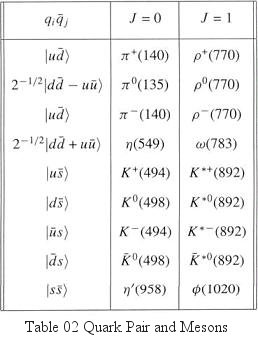
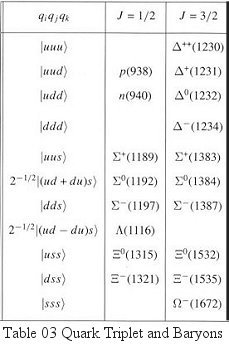
where J is the total angular momentum quantum number. The mesons in the
middle column belongs to J = 0, while those in the right column belongs to J
= 1. In terms of the meson wave functions the octet in Eq.(21) can be re-written
in the form of
Eq.(22). Similarly, the baryon wave functions are related to the quark
triplet as shown in Table 03 and Eq.(23).
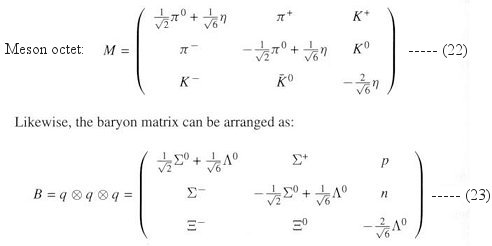
This is the Eightfold Way originally proposed by Gell-Mann and Neman in
1961. The mass splitting is caused by various interactions as shown in
Figaure 03 below:
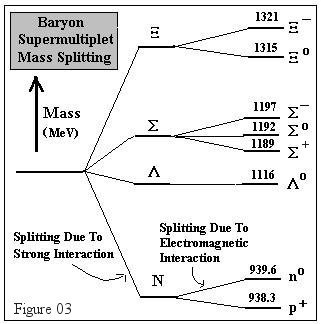
Hiçbir yazı/ resim izinsiz olarak kullanılamaz!! Telif hakları uyarınca bu bir suçtur..! Tüm hakları Çetin BAL' a aittir. Kaynak gösterilmek şartıyla siteden alıntı yapılabilir.
The Time Machine Project © 2005 Cetin BAL - GSM:+90 05366063183 -Turkiye/Denizli
Ana Sayfa /index /Roket bilimi /![]() E-Mail /CetinBAL/Quantum Teleportation-2
E-Mail /CetinBAL/Quantum Teleportation-2
Time Travel Technology /Ziyaretçi Defteri /UFO Technology/Duyuru
